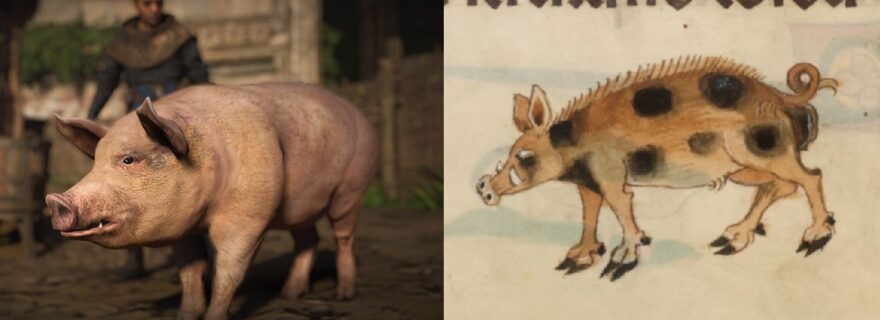What’s wrong with medieval pigs in videogames?
Some medieval videogames claim historical authenticity, but one particular farm animal is often overlooked...
Scholars have often remarked that pop-culture stereotypes regularly prevail over historical authenticity when it comes to depicting medieval life in modern entertainment media. Understandably, videogames are no exception to this trend. In this article, I would like to talk about a part of the medieval décor that is consistently misrepresented in “medieval” videogames but rarely talked about: the depiction of our favourite barnyard animal, the domesticated pig.
Pigs in medieval videogames
In videogames, medieval pigs are generally modelled on their modern-day counterparts: as rotund furless animals with pink skin and stubby legs. We find this historical faux-pas in city building games like Foundation, survival games like Medieval Dynasty or role-playing games like Assassin's Creed: Valhalla. Even a visual gem such as A Plague Tale Innocence, which is set in fourteenth-century France, has massive hogs hobbling around. That the medieval pig looked markedly different, however, is a well-established fact which can be verified from a plethora of evidence.
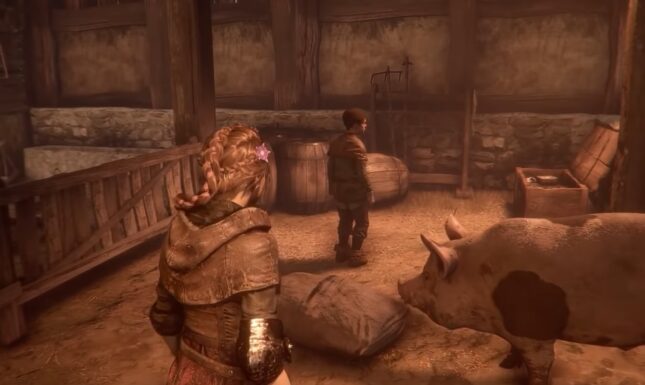

What is wrong?
Medieval iconography and animal remains found at archaeological sites indicate that the domesticated pig in the middle ages was a long-legged small creature with a long snout and a lean figure. It had an arched crested back and, unlike modern pigs, long curved tusks. Most notably, however, the medieval pig was not naked and pink at all, but covered in long dark hairs. In appearance, it was therefore not dissimilar to a boar with which it was often cross-bred. Even in the seventeenth century - long after the middle ages - domestic pigs retained some of these traits, as the drawing below from 1610 shows.
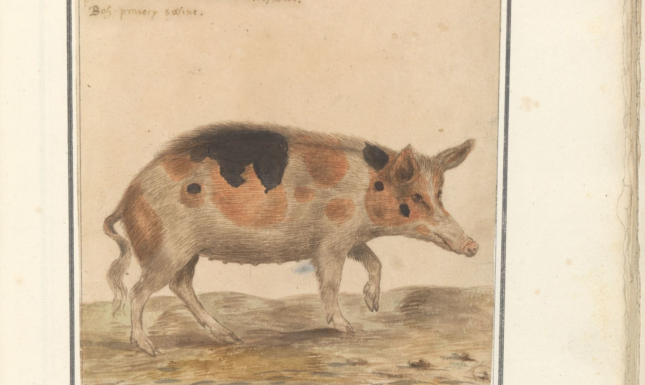
This brings us to the next issue. In videogames, we find medieval pigs either rolling around in their pigsties or wandering the village streets. For most of the Middle Ages, however, pigs were often not in the village at all, but herded communally on a fallow field or let out to graze in enclosed parts of the forest. In December, still fat from eating the autumn mast, some of them could then be butchered for their meat and bacon. The custom of letting the pigs forage in the forest is known in the scholarly literature as pannage and constituted one of the main fixed rights of the village community.
Pigs in medieval laws
Our sources on medieval pig-rearing extend far back into the middle ages as pigs are prominently featured in the law codes of early medieval Europe. Here we find ample information on pig husbandry and how the animal was valued in the rural societies of before 1100 CE.
For example, according to sixth-century Merovingian law, pigs were herded in a sounder that consisted of twenty five to fifty females led by a matriarch. While the animals were grazing, a swineherd kept watch, a task so important that he enjoyed the same kind of legal protection as a blacksmith.
Furthermore, almost all early medieval law codes presuppose the custom of forest grazing: in Merovingian law, swineherds were granted free passage over any forest road; Longobardic law lists the offense of sending pigs to feed in someone else’s wood; in Anglo-Saxon law, felling a tree that could shelter thirty pigs invoked double the fine of a small tree. Further details on the mast season are found in Early Medieval Irish and Welsh sources; in Ireland, pigs were sent into the forest in August and in Medieval Wales the season ran from September to the start of January.
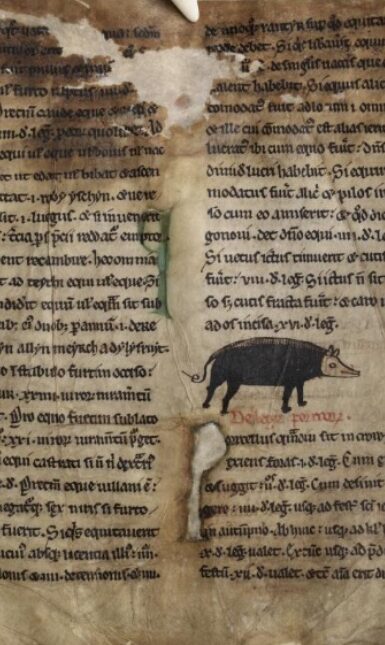

Welsh law is also informative on the valuation of different kinds of pigs since it provides a detailed list of compensation tariffs in case of pig theft. Understandably, the theft of the matriarch and the (breeding) boar incur the highest compensation with the high value of the breeding boar stemming from the fact that its use was communal. Merovingian law also deals with pig theft and - rather uniquely - includes tariffs for stealing castrated boars (barrows) who are left unmentioned in many other law codes.
So, were there any pigs around the medieval farm at all? Yes, in the early middle ages breeding sows and piglets were kept on the farmyard in enclosures and lockable pens. There, piglets would mature slowly over a period of three years and only adolescent grunters were allowed to join the sounder in the forest or at the field. Also, as the middle ages progressed and the amount of available woodland shrunk, free-range husbandry was steadily being replaced by farm-rearing and pigs were increasingly kept closer to the village. However, in many parts of Europe the medieval pannage system survived into modern times. The popular image of the medieval pig as predominantly a farm animal is therefore misinformed.
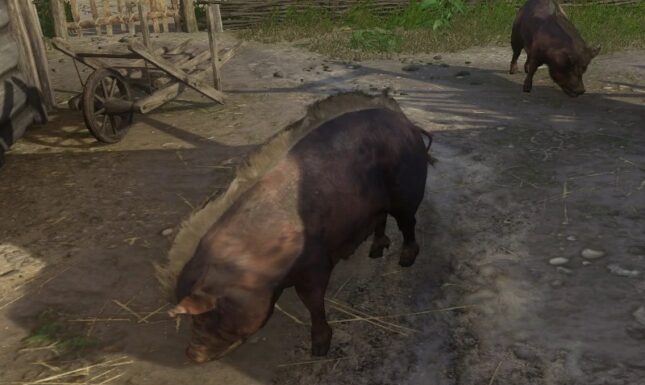
Conclusion
What needs to change for the depiction of pigs in videogames to become more accurate? Well, it would help if medieval pigs were no longer modelled on modern barnyard animals with big pink bellies and chubby short legs. With their ability to digitally animate fantastical fauna, videogames are the perfect medium for breaking with the stereotype and bringing academic insights to the larger public. It seems presumptuous to assume that a majority of the videogame audience will be bothered by several small high-legged swine roaming the background of their escapism. Soon, perhaps, a game developer may take up the gauntlet and choose to animate some furry pigs wandering happily around his medieval décor.
Can't get enough of medieval pigs? Check out these hog blogs on the Leiden Medievalists Blog!
Bibliography
- The albums of Anselmus de Boodt (1550-1632): natural history painting at the court of Rudolph II in Prague. This source can be consulted here.
- Banham, D. & R. Faith (2014). Anglo-Saxon Farms and Farming. Oxford University Press, Oxford.
- Kreiner, J. (2020). Legions of Pigs in the Early Medieval West. Yale University Press, New Haven & London.
- Kelly, F. (1997). Early Irish farming: a study based mainly on the law-texts of the 7th and 8th centuries AD. Dublin Institute for advanced studies, Dublin.
- Drew, K. F. (1973). The Lombard Laws; translated and with an introduction by Katherine Fischer Drew, University of Pennsylvania Press, Philadelphia.
- Drew, K. F. (1991). The Laws of the Salian Franks; translated and with an introduction by Katherine Fischer Drew, University of Pennsylvania Press, Philadelphia.
- Peniarth MS 28 containing the Laws of Hywel Dda. This source can be consulted here
- Rivers, T. J. (1977). Laws of the Alamans and Bavarians; translated, with an introduction, University of Pennsylvania Press, New York.
© Peter-Alexander Kerkhof and Leiden Medievalists Blog, 2021. Unauthorised use and/or duplication of this material without express and written permission from this site’s author and/or owner is strictly prohibited. Excerpts and links may be used, provided that full and clear credit is given to Peter-Alexander Kerkhof and Leiden Medievalists Blog with appropriate and specific direction to the original content.


